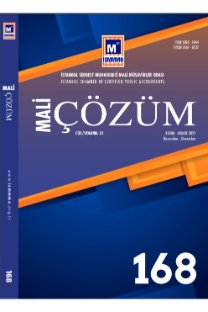VERGİ USUL KANUNUNA GÖRE AMORTİSMAN YÖNETİMİNİN TERCİH EDİLMESİNDE PARANIN ZAMAN DEĞERİ YAKLAŞIMI
Amortisman yönteminin tercih edilmesi Uluslararası Muhasebe Standartlarıçerçevesinde varlığın gerçeğe uygun değerinin gösterilmesi amacıylaişletmenin perspektifinden değerlendirilen bir husus iken, ülkelerin vergimevzuatları karın daha düşük gösterilmesi hususunda işletmeleri farklıamortisman yöntemlerine itmektedir. Türk vergi mevzuatına göre normalveya hızlandırılmış amortisman yöntemlerinden birini seçmek mümkündür.Buna doğrultuda işletmeler, hızlandırılmış amortisman yönteminden normalamortisman yöntemine geçebilmektedir. Bu kapsamda çalışmanın amacıböylesi bir yöntem değişikliği ve zamanlamasının vergi mükellefi ile vergiidaresi açısından doğuracağı sonuçları paranın zaman değeri bakış açısıylaincelemektir. Paranın zaman değeri dikkate alınarak amortisman yönteminintercih edilmesinde hızlandırmış amortismandan normal amortismana geçişyapmanın bir işletmenin nakit varlığını elde tutma ve vergi ötelemesi açısındanfaydası olduğu sonucu ortaya çıkmıştır.
TIME VALUE OF MONEY APPROACH FOR PREFERRING OF DEPRECIATION METHOD IN ACCORDANCE OF TURKISH TAX LEGISLATION
Although depreciation method is an issue evaluated by businesses in order to express the fair value of asset according to International Accounting Method, tax codes of a countries cause to preferring different depreciation methods in order to express the profit less than fair value. According to Turkish Tax Legislation, normal or accelerated depreciation methods can be preferable. In addition, accelerated depreciation may be switched to normal depreciation. For this reason, goal of this study is to investigate the results of suchlike changeover for both taxpayer and tax administration in context of value of money. It has been revealed that switching to normal depreciation from accelerated depreciation method have positive effect on holding cash and deferring tax for any business.
___
- 213 Sayılı Vergi Usul Kanunu. (04.01.1961). Ankara: Resmi Gazete Erişim Adresi: http://www.mevzuat.gov.tr/MevzuatMetin/1.4.213.pdf, Erişim Tarihi: 25.09.2019
- 5432 Sayılı Vergi Usul Kanunu (07.06.1949). Ankara: Resmi Gazete. Erişim Adresi: https://vergidosyasi.files.wordpress.com/2017/07/5432- sayc4b1lc4b1-vergi-usul-kanunu-kanun-tbmm-c03105432.pdf, Erişim Tarihi: 25.09.2019
- Aykın, H. (2017). Zamanda Kısa Yolculuk: 1949 Tarihli 5432 Sayılı İlk Vergi Usul Kanunundan 213 Sayılı VUK’a, Erişim Adresi: https://vergidosyasi. com/2017/07/26/zamanda-yolculuk-1949-tarihli-5432-sayili-ilk-vergi-usulkanunundan-213-sayili-vuka/, Erişim Tarihi: 25.09.2019
- Brealey, R. A., Myers, S. C., and Marcus, A. J. (2001). Fundamentals of Corporate Finance 3.ed. [y.y.] : McGraw-Hill.
- Büyükmirza, H. K. (2019). Maliyet ve Yönetim Muhasebesi: Tekdüzen’e Uygun Bir Sistem Yaklaşımı 23.bs. Ankara : Gazi Kitabevi.
- Carmichael, J., and Stebbing, P. W. (1983). Fisher’s Paradox and the Theory of Interest. The American Economic Review, 73(4), 619-630.
- Chen, J. (2019). Time Value of Money – TVM. Erişim Adresi: Investopedia. https://www.investopedia.com/terms/t/timevalueofmoney.asp, Erişim Tarihi: 26.03.2019
- Deran, A., ve Yakupçebioğlu, N. S. (2006). Türk Vergi Mevzuatında Amortisman Muhasebesi. Mevzuat Dergisi, 9(104), 2. Erişim Adresi: https:// www.mevzuatdergisi.com/2006/08a/01.htm, Erişim Tarihi: 24.03.2019
- Edison. (2019). Edison Explains: Time Value of Money. Erişim Adresi: https:// www.edisongroup.com/wp-content/uploads/2019/04/Time-value-of-money. pdf, Erişim Tarihi: 07.11.2020
- Gökçen, G. (2015). Genel Muhasebe: İlkeler ve Tekdüzen Hesap Planı Uygulamaları. İstanbul : Beta Yayıncılık.
- Gözüm, S. M., ve Yücel, G. (2016). Yönetim Kurulu Üyeleri İçin Finans 2. Bs. [y.y.] : Hümanist Kitap Yayıncılık.
- Heyford, C. S. (2019). Understanding the Time Value of Money. Erişim Adresi: Investopedia. https://www.investopedia.com/articles/03/082703.asp, Erişim Tarihi: 26.03.2019
- Hou, S. (2017). Value-For-Money Assessment in China’s Public-PrivatePartnership Project Present Situation, Problems and Policy Suggestions. In 2017 4th International Conference on Industrial Economics System and Industrial Security Engineering (IEIS) (pp. 1-4). IEEE. doi: 10.1109/ IEIS.2017.8078650.
- Kandel, S., Ofer, A. R., and Sarig, O. (1996). Real Interest Rates and Inflation: An Ex‐ante Empirical Analysis. The Journal of Finance, 51(1), 205-225.
- Millet Meclisi 64’nolu Komisyon Raporu - 1.Dönem. (1963). Erişim Adresi: https://www.tbmm.gov.tr/tutanaklar/TUTANAK/MM__/d01/c012/ mm__01012045ss0064.pdf, Erişim Tarihi: 26.06.2019
- Nickolas, S. (2020). Real vs. Nominal Interest Rates: What’s the Difference?. Investopedia. Erişim Adresi: https://www.investopedia.com/ask/ answers/032515/what-difference-between-real-and-nominal-interest-rates. asp, Erişim Tarihi: 07.11.2020
- Petters, O. A., Dong, Xiaoying. (2016). The Time Value of Money. An Introduction to Mathematical Finance with Applications Understanding and Building Financial Intuition. [y.y.] : Springer.
- Piros, C. D., and Pinto, J. E. (2013). Economics for Investment Decision Makers: Micro, Macro, and International Economics. [y.y.] : John Wiley & Sons.
- Türkiye Cumhuriyeti Merkez Bankası (TCMB) (29.06.2018). Reeskont İşlemlerinde Uygulanacak İskonto Faiz Oranlarının Tespiti., Erişim Adresi: http://www.resmigazete.gov.tr/eskiler/2018/06/20180629.pdf, Erişim Tarihi: 26.03.2019
- ISSN: 1303-5444
- Yayın Aralığı: Yılda 6 Sayı
- Başlangıç: 1991
- Yayıncı: İstanbul Serbest Muhasebeci Mali Müşavirler Odası
Sayıdaki Diğer Makaleler
FİNANSAL VE EKONOMİK FAKTÖRLERİN VERGİ GELİRLERİ ÜZERİNE ETKİSİ: TÜRKİYE ÖRNEĞİ
DİJİTAL EKONOMİLERİN VERGİLENDİRİLMESİNDE OECD UYGULAMALARI VE TÜRKİYE KARŞILAŞTIRILMASI
MUHASEBEDE HOLİSTİK YAKLAŞIM – FELSEFİK BİR BAKIŞ
M. Serdar ATAY, Neriman POLAT ÇELTİKCİ
VERGİ USUL KANUNUNA GÖRE AMORTİSMAN YÖNETİMİNİN TERCİH EDİLMESİNDE PARANIN ZAMAN DEĞERİ YAKLAŞIMI
ERTELENMİŞ VERGİLERİN DÖNEM NET KÂRINA ETKİSİNİN ANALİZİ
ÇOK BOYUTLU BİR MUHASEBENİN İDEOLOJİSİ: MUHASEBENİN FİNANSALLAŞMAMASI
